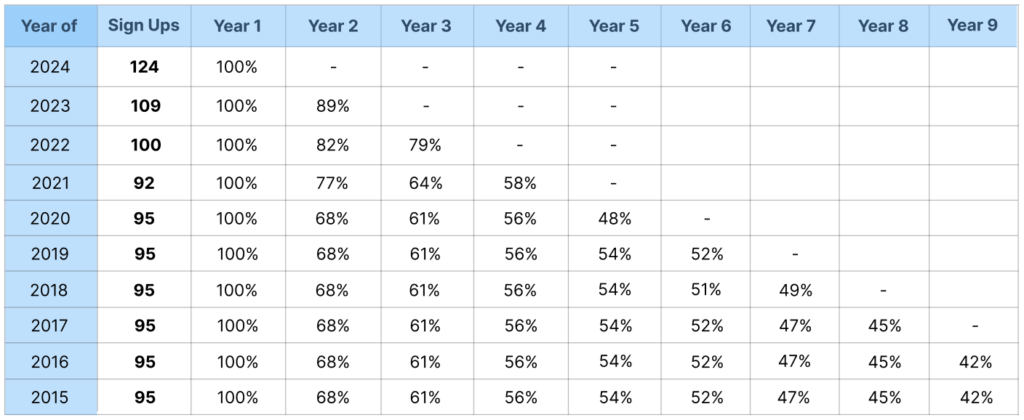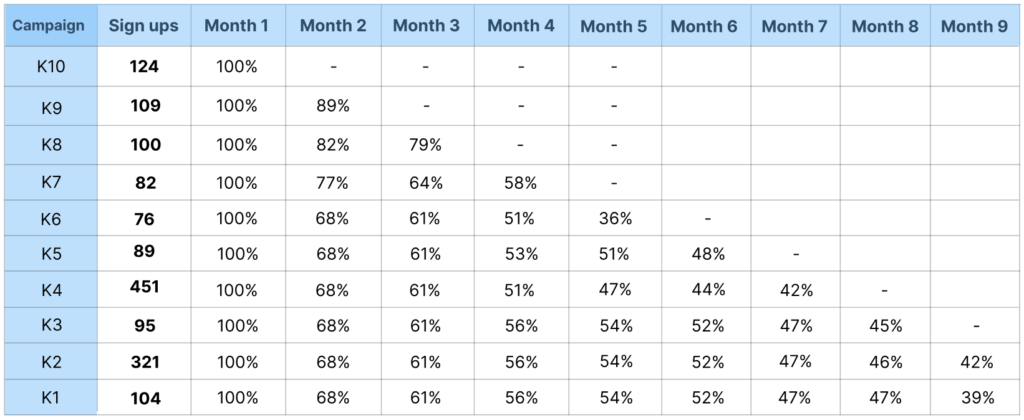By Morten Suhr Hansen
As subscription enthusiasts, we often claim that one of the benefits of running a subscription business is the access to vast amounts of data and knowledge about our customers, their purchases, and behavior.
This data presents a business opportunity for further growth, but the challenge lies in how best to approach and utilize it. Cohort analysis emerges as a crucial tool in this context, acting as a ‘highway’ towards a deeper understanding of our business and subscribers’ behavior.
It serves as the secret code to uncover why some subscribers leave while others remain loyal, creating significant value over time. Thus, diving into cohort analysis can unlock more insights into your subscription business.
Time-based cohort analysis is a good place to start
Let’s begin by clarifying the terms. A cohort refers to a group of individuals sharing a common characteristic or experience within a defined time period, essentially segmenting the overall customer base into smaller, comparable groups.
Cohort analysis is a behavioral analysis method aimed at understanding the behavior of such a group over time. In the subscription world, this often involves tracking the churn profile of customers who start a subscription in the same month and observing it over time to gain nuanced insights into churn patterns, identifying vulnerable moments in the subscriber journey, and developing effective strategies to improve retention.

Figure 1: Example of a time-based cohort analysis
This time-based cohort analysis is highly recommended as a starting point and should be a standard practice in any subscription business. However, there are many more “codes” to decipher with even more advanced cohort analyses for deeper insights.
Cohorts split on different sales campaigns can create new insights
Consider cohort analysis as your tool to link various variables to understand why some subscribers leave while others stay loyal. Variables like the campaigns that initially attract subscribers, which can be evaluated not just on conversion rates and customer acquisition cost (CAC) but also on their long-term value creation.
Additionally, payment methods can influence retention, suggesting a need to analyze which are more effective over time.
Other variables might be business-specific, prompting an examination of customer- or product-level factors to further segment your cohorts for deeper insights.

Figure 2: Example of campaign-based cohort-analysis
Try using behaviour instead of time, when building your cohorts
The above cohort analyses are all time-based in relation to when the subscriber started. As mentioned, it’s an excellent place to start, but perhaps it actually makes sense to move from time-based to behavior-based cohorts?
At least that’s the opinion of American data scientist Carl Gold, who has written ‘Fighting churn with data’, which is precisely about the use of data in subscription businesses, and how they are best utilized to prevent churn and ensure long-term viability.
First and foremost, it’s about identifying the factors that actually drive subscriber churn. Here, Carl Gold introduces ‘behavioral cohorts’ as an alternative to traditional time-based cohort analyses. Behavioral cohorts look at which behaviors among customers actually drive churn and to what extent. With a little bit of skillful data work, these analyses can provide the company with much better and more nuanced insight into what actually drives churn (other than customer seniority, which isn’t something that can be changed much) and thus lay the groundwork for assessing whether it’s better customer communication, an enhanced product, or a changed packaging that can alter the number of subscribers exiting the bottom of the bathtub.

Figure 3: Example of a behavioural cohort-analysis. Source: Gold, C. (2020) Fighting Churn With Data
Understand the dynamic in your subscription business and create actions
Admittedly, describing how subscription businesses can and should work with cohort analyses in as short a format as this is almost like putting oneself on the spot. There are (and have been) thick books written about it!
My experience is just that there are too few subscription companies that delve deep enough into this powerful tool, which offers so many possibilities for insights combined with the opportunity to work proactively and forward-looking to improve the customer experience and thus create increased loyalty and retention.
A good starting point is time-based cohort analyses, combined with the variables that make sense for your business. This will give you a solid foundation for understanding the dynamics of your subscription business and enable you to implement measures that can reduce churn at those critical points in the customer journey.


